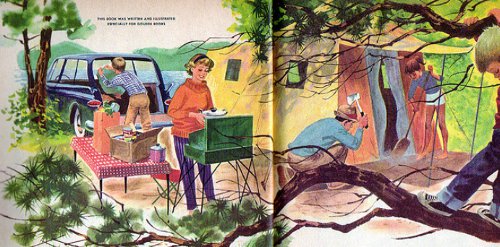
My generation (nearly 50 years old) had an extensive range from home base. We’d disappear for a day. No helicopter parents, no cell phones. If we crashed our bikes, we fixed them as best we could and limped home. I took a nice digger five miles from home (I still have the scar on my chin), used a t-shirt as a bandage, and a Good Samaritan took me home, and from there to the emergency room. I got 25 stitches and ate small things for a few days. I picked gravel out of my chin for years after that.
The truth is that the world is no more dangerous than it was 40 years ago, but 24-hour news channels have tricked us into thinking that if a kid spends more than half an hour outside, he’ll be eaten by a puma. Lightning strikes every kid who steps in a puddle. A laceration will lead to a flesh-eating bacteria. CNN says it. It must be true.
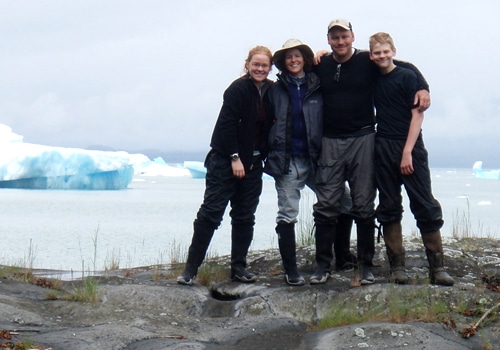
Our family is bucking a trend. Maybe it’s because we don’t have cable and find CNN, Fox News, MSNBC and the Home Shopping Network a waste of electrons. If given a chance between outside and inside, both my kids will choose outside irrespective of conditions. They know there’s no such thing as bad weather, just the wrong clothing. Since my kids have been dirt moles and water rats since they could sit up and hold their own weight, I am often asked, “When is the best time to start taking kids on outdoor excursions?”
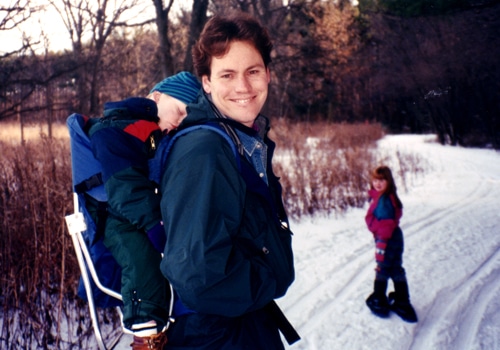
My answer is always the same: on the way home from the birthing center. We owe it to our kids…heck, we owe it to all kids to get them outside. Television has its place, but it is hardly an active, manly pursuit. If the only injury children experience is repetitive motion syndrome from playing X-Box, our species is doomed. We owe them scratches and scrapes, summits and snakes, sunburns and sunsets. We owe them an authentic life.
Practical Matters
Kids are not little adults. Their needs are very different, and if you want to enjoy your time with kids, pay attention. There are five things I tell people when they ask about taking kids camping or hiking or paddling:
- They get cold faster.
- They get hot faster.
- They get hungry faster.
- They get bored faster.
- They want to be helpful.
Note #1: For the sake of ease of writing I’ll talk about kids as if they are your own. However, this information is as good for uncles, grandfathers, and other role models.
Note #2: Many of the same rules apply to taking babies camping, but we’ll tackle that situation separately down the road.
They get cold faster. It’s simple thermodynamics. Little bodies lose heat faster than big ones. They get cold before you do, so don’t assume because you’re not cold that your little ones aren’t either. This is especially true in cases where you’re active (paddling a canoe or what have you, generating heat) and they aren’t (sitting in the canoe, shivering).
The solution is easy. Take more clothing than you think necessary. Because their clothes are smaller, it’s no big deal, and after a certain age (around six for our kids) they started carrying a lot of their own clothes and gear.
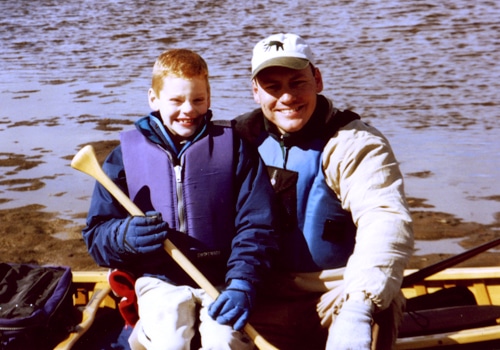
The first line of defense is good outerwear. Make sure it fits: boots, raingear, hats, gloves, etc. The difference between a good raincoat and a poncho is not worth it, especially when you have a wet and tired and hungry five-year-old. Suddenly the extra $25 seems like a bargain. Rain hats are particularly important. Keeping little noggins dry goes a long way in keeping them warm.
Layer them up. Fleece is great, but a good wool sweater will work as well. A warm head is a happy head, so wool or fleece caps are great even under a rain hat.
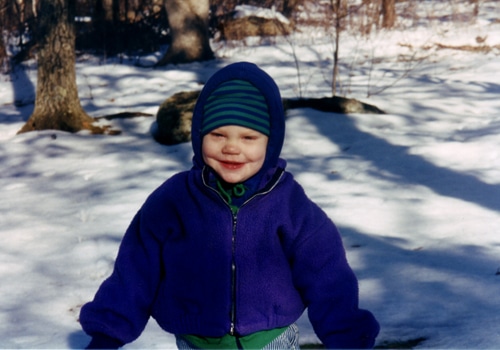
It’s true that many kids outgrow their clothing before it wears out. Take the sting out of it by starting a kid’s clothing swap with other outdoor friends. Sometimes local outdoor stores will provide a venue for such trade.
For non-clothing items, you can tweak things a bit. An adult sleeping bag will work fine for a kid if you use a piece of webbing to tie off the bottom of the sleeping bag so their little bodies don’t have to heat up the whole bag. It works fine. Down bags are generally less desirable for little ones who may still lack bladder control. Synthetics have come a long way.
They get hot faster. Of course they do. Keeping kids comfortable in the heat is just as important as keeping them warm. Again, you may not notice because you’re not hot. A red flushed complexion is a good sign things are toasty. Make use of evaporative cooling. A baseball cap dipped in water can cool them off quickly, and a wet bandana around the neck is helpful too.
Long-sleeve nylon wind shirts are wonderful for everyone. They keep off the sun but allow air to move freely. A wind shirt is one of my key pieces of gear for paddling, hiking, or backpacking.
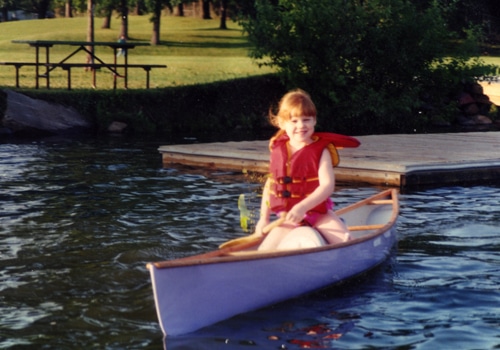
It goes without saying that many adults forget to apply (or reapply) sunscreen. If you forget, chances are it’s not even on your kid’s radar. Make it a point to reapply every hour, even if it’s just a touch-up. Let the kids be in charge of watching the clock. A bad sunburn can ruin a trip in an hour. Prevention is the best cure.
They get hungry faster. That’s probably not exactly true, but it is a fact that my kids would not tolerate hunger as well as we did. Rather than three squares a day, count on feeding them snacks throughout the day as well as good sized portions at breakfast and dinner. You will be shocked at how many pancakes a hungry twelve year-old can wolf down after a few days of outdoor life.
Keeping high-energy snacks handy is critical and can help avoid meltdowns. Gummi worms worked for our kids, with the added benefit that we got to chug a few once in awhile. Granola bars, GORP, etc. are best packaged in small baggies to be dealt out as needed. Bonus: the kids can help prepare it before the trip.
This is not the time to withhold calories. If your kid is overweight, don’t use the outdoors as an amateur fat camp. They’ll resent you and hate the outdoors. Feed ’em lots of good fat and carbohydrate-rich foods. They’ll burn it off with activity, plus their bodies burn more in general to keep their temperature regulated when there’s no thermostat.
They get bored faster. This is especially true with passive activities when they’re younger, like sitting in a canoe while Mom and Dad do all the work. Again, they’re not little adults, and I’ve seen adults who are unable to grasp the opportunity to observe the world around them.
Be fair; don’t expect a kid to have the attention span of an average adult. Darren’s Rule is that for every year of age, a child can stand about 15 minutes of an activity before they need a change. It has worked every time. Just a few weeks ago I took some friends for a little river paddle with their kids, eight and ten. After two hours, the eight year-old started poking the ten year-old, almost to the minute. A half-hour later the ten-year-old wanted blood. We stopped, did something else for a while (chased dragonflies on shore) and we were able to continue. No problem.

For base camp, coloring books, plain white notebooks and crayons and colored pencils are great. After a certain age, kids can whittle, which seems to captivate all kids, even 49-year-old kids. Another sure-fire winner is an old fashioned game of mumbley peg. A good book or two is essential for my kids. A portable cribbage board is essential for our family.
We have some family games that help a lot. When Daughter 1.0 was about four we took her to the north woods for a week in a canoe. She was great, but a little fidgety after a few hours so we played Cash for Critters. A squirrel was a nickel, a gray jay or loon was a dime, a moose a quarter, and a dollar for a bear. This kept her busy for hours, she saw things we’d miss, and it cost me, if memory serves, $1.85. It’s not really about the money; that’s just a tally mechanism. You can use jelly beans if you want to. The point is to give them a goal. Wildlife Bingo. Tree Bingo. Alphabet games. Anything to stimulate their minds.
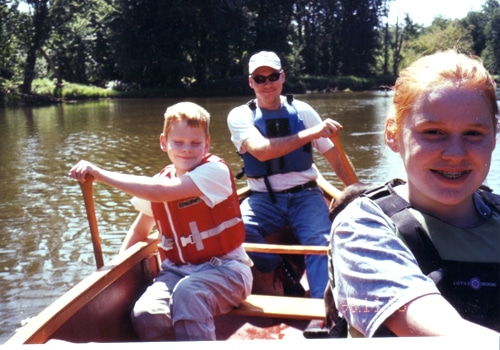
We also sing. Voyageurs used songs to keep in cadence when paddling together. We use “great green gobs of greasy grimy gopher guts…” We tried to make additional verses. Even the kids took it to PG-13 quite quickly, so it’s back to gopher guts.
They want to be helpful. Our kids were always helpful in camp because they had assignments that were age appropriate. At four, a kid can collect twigs for tinder; at six, pump a water filter. At eight, they can help start the fire, and at ten they can start the fire themselves. At twelve they help with dinner; by fourteen they’re cooking dinner.
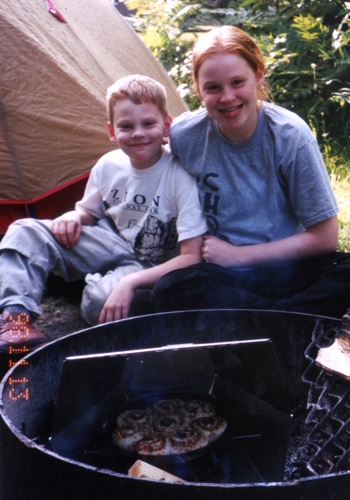
Kids want to be useful. Resist the temptation to do everything because it’s faster. Hey, Einstein, if you are in such a hurry, why are you camping? Put your Blackberry away and be present. Here’s a chance to coach. It’s pretty cool to see a ten-year-old lift the lid on a Dutch oven to see his first cobbler.
About Safety and Risk
Taking these axioms and applying them without an eye toward safety is foolhardy. Clearly, you want to pay attention to safety, but realize that there is inherent risk in outdoor activities. The key is to minimize risk through education.
If you are going more than a 9-1-1 call from help, you’ll want some training. Wilderness First Aid (WFA) is a weekend course designed to give you a basic understanding of dealing with injuries and other mishaps that happen outside. If you’re hard core, the Wilderness First Responder (WFR) is an eight-day comprehensive course that teaches you how to provide some pretty serious aid while waiting for the professionals. If you’re an EMT, there is specialized training for you to fill in the gaps when it comes to wilderness.
I still hear from people who question my sanity about taking my kids into wilderness areas. I have had people question my sanity for much better reasons than that. My response is that I minimize risk through planning, education and keeping my wits about me. I also tell them that the risks of not taking my kids to the rivers and woods are far higher than if I take them. They may be more physically safe sitting in front of a big screen playing Wilderness Bear Assault III, but their souls are shriveling on the vine.
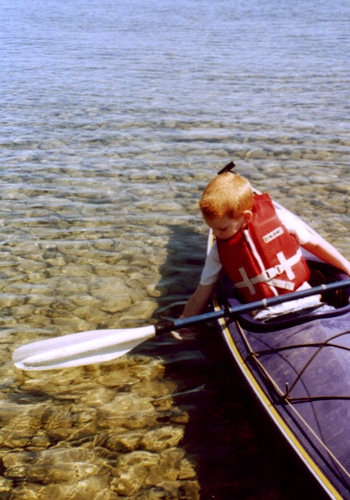
Risk cannot be eliminated, but it can be managed. Only a foolish man faces the wilderness with a pocket knife, a piece of twine, and a can-do attitude. A wise man educates himself, teaches others, and shares his knowledge generously and graciously. After all, he had a mentor who taught him his skills. It is gentlemanly to pass them on to the next generation. A man who teaches children has a legacy that may stretch generations.
What are you tips for camping with kids? Share them with us in the comments!


